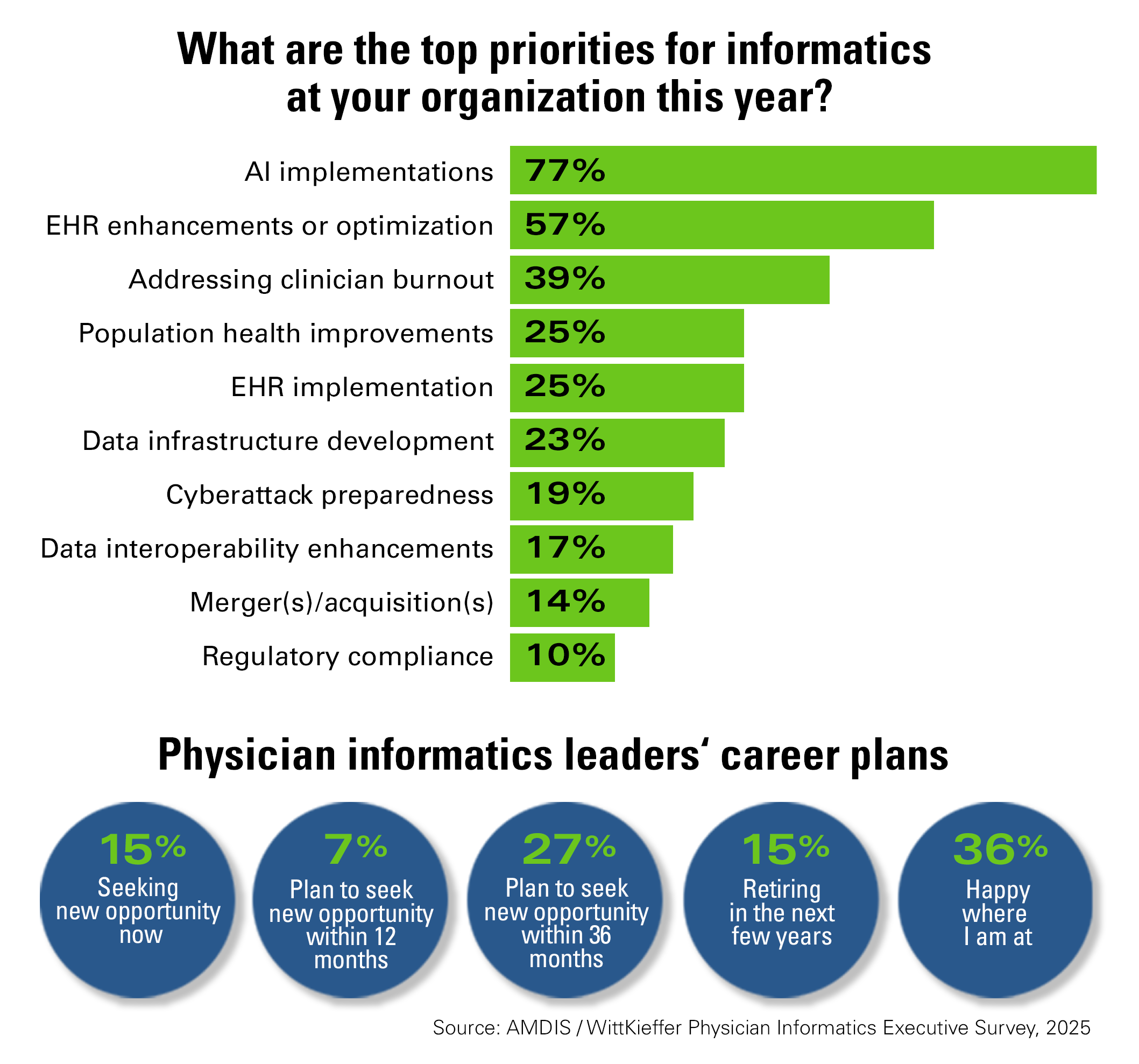

3 Takeaways to Retain Top Clinical Informatics Talent

Physician informatics leaders have been assuming a wider role in hospitals and health systems in recent years as artificial intelligence (AI), digital transformation and IT governance take on greater strategic importance.
This broadening of roles has come with shifting priorities and in some cases growing pains, according to a recent survey report from the Association of Medical Directors of Information Systems (AMDIS) and the consultancy WittKieffer.
Underlying Challenges Surface
While the respondents generally depict a positive evolution of roles and responsibilities in medical informatics, open-ended responses expose underlying challenges. Many of the 160 respondents noted that the expansion of their duties often results in a “do more with less” situation, rather than an increase in the recognition or value attributed to informatics.
This is primarily due to budgetary constraints, limited funding for new roles and hiring freezes, which highlight the financial pressures many organizations face, the report states.
Data show that 83% of informatics leaders say their responsibilities have increased over the past two years. Areas with the most significant growth include:
- 95% AI tools and machine learning algorithms
- 50% Digital transformation
- 45% Governance and prioritization
Top priorities for informatics this year
More than one-quarter (29%) of chief medical informatics officers (CMIOs) now hold direct responsibility for organizational AI initiatives. The leading strategic informatics priorities for this year, according to respondents are:
- 77% Implementing AI applications
- 57% Optimizing electronic health records (EHRs)
- 39% Addressing clinician burnout
- 25% Population health improvements
- 25% EHR implementation
Implementation of vendor solutions (86%), AI strategy development (82%) and governance framework responsibilities (81%) constitute primary AI responsibilities, while only 34% report involvement in developing in-house solutions.
This pattern suggests that health care organizations frequently leverage vendor expertise rather than developing internal capabilities, the report states.

Talent Dynamics: Recognition, Training and Retention
Nearly nine out of 10 respondents say they are “very satisfied” or “satisfied” with their current job. They say positives in their role include collaborating with other departments, communication with executive leadership and feeling valued by colleagues and the organization.
Nevertheless, the CMIO landscape is dynamic, with those in the profession having a strong appetite for career growth, the report’s authors note. This creates both opportunities and risks for health care organizations striving to maintain stable informatics leadership.
The space is poised for ongoing turnover as 64% of physician informatics leaders are contemplating changing roles or retiring soon, the survey data showed. This raises concerns regarding leadership continuity within organizations.
Interestingly, only 21% of organizations have established succession plans for leading medical informatics positions such as CMIOs, chief health informatics officers (CHIOs), associate CMIOs and associate CHIOs, the report states; 52% have no plan in place and 27% are still creating one.
In addition, nearly three-quarters of the medical informatics leaders identified team upskilling and creating development opportunities as their two most significant talent-related challenges. Nearly half cited improving team culture as a key challenge.
3 Takeaways for Health Care Leaders
The report’s authors offer these recommendations to health care executives responding to today’s changing dynamics in the market for physician informatics leaders.
1 | Enhance recruitment efforts.
Attracting top-tier candidates requires more than a compelling job offer. Organizations should highlight their forward-looking technology strategies and commitment to innovation to appeal to candidates who aspire to be at the forefront of advancements in the field. Emphasize the supportive community and development opportunities to position your organization as a place where candidates can thrive, grow and make a significant impact.
2 | Rethink retention efforts.
To retain top talent, organizations should engage CMIOs in strategic innovation projects that align with their desire for career growth and impact. Prioritize upskilling and development opportunities, such as training programs and mentorship. Foster a positive team culture by encouraging open communication, recognizing achievements and promoting work-life balance to improve employee satisfaction and loyalty.
3 | Prioritize succession planning.
Develop a succession strategy to align talent with emerging needs by carefully evaluating your team’s technological goals and targeting talent that can achieve these objectives. A structured succession process can reduce the administrative burden on clinicians, improve patient outcomes and position organizations as market leaders.



